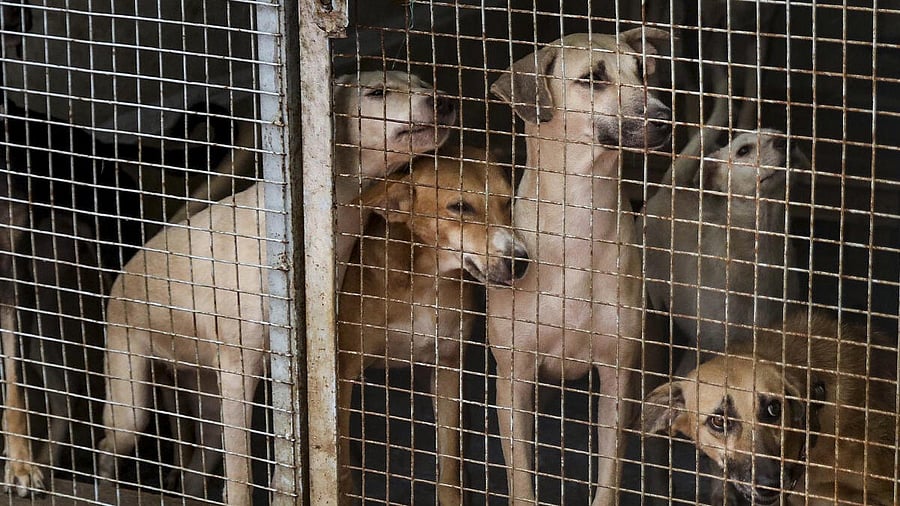
Stray dogs at a dog shelter at Sector 34 area, in Noida, Gautambuddha Nagar district, Uttar Pradesh, Aug. 11, 2025.
Credit: PTI Photo
On August 11, the Supreme Court of India called for Delhi-NCR's 10 lakh community dogs to be rounded up in shelters. That is like rounding up your next-door neighbour. Many of us came to the national capital from elsewhere; these dogs have lived here for generations. They are Delhiites, through and through, simply trying to survive like the rest of us.
This court direction is impractical, misguided, and cruel. It also appears to contradict the law: The Animal Birth Control (Dogs) Rules, 2001, and the 2023 Rules that replaced them, require that community dogs be humanely caught, sterilised, and vaccinated, and then returned to the exact place they were found. Routine displacement is, thus, unlawful.
For those who feed and watch over them, the court directive feels like an eviction notice for family. These dogs are Rani at the metro station, Sheru escorting children from tuition, and Kaalu guarding the corner tea stall. As anyone who has spent any time with them would profess, each dog is an individual with a unique personality. Indeed, that’s why public figures — like Anushka Sharma and Virat Kohli, Raveena Tandon, and John Abraham — have opened their homes to community dogs. Their absence in our neighbourhoods would be deeply felt by the many who love them.
Take Tiger, the community dog who made the Chennai central railway station his home, for example. Simply by observing, Tiger learned policing routines. When a man tried to flee with a stolen phone, Tiger sprang into action and helped the Railway Protection Force nab him. Stories like this remind us that community dogs are neighbours who notice, respond, and protect us. Now, when it is time to protect them, we must not let them down.
Get the ABC right
Despite all this, the idea of removal persists. Also on August 11, the Rajasthan High Court directed all municipal bodies to remove community dogs and other animals from public places. News reports indicate that if Bengaluru were to implement the apex court order and move in community dogs to shelters, it would need to scale up existing infrastructure by nearly 1000 times!
But previous attempts at killing and displacing dogs showed us displacing dogs does not eliminate them; it triggers the 'vacuum effect'. Shelters are supposed to be temporary homes for dogs before adoption or during recovery from medical care or sterilisation.
Even if efforts were made to implement the court directive with the best intents, there can never practically be enough shelters to house community dogs. And so, remove dogs from an area and others quickly take their place, often unsterilised, unvaccinated, and unfamiliar to residents — raising competition for food and territorial disputes.
The court directed that, whether sterilised or not, dogs be removed. But sterilised dogs are vaccinated against rabies. Since sterilisation surgeries prevent births, sterilised dogs no longer have puppies to protect while having more opportunities to feed themselves. This results in calmer, happier dogs, and reduces fights and bites. Because dogs are territorial, they largely prevent new dogs from entering areas they occupy. Numbers of dogs in cities only remain high when an animal birth control (ABC) programme is inadequately implemented at the needed scale.
Where the ABC is done seriously, results follow. In Jaipur, thanks to the work of Help in Suffering, sustained sterilisation and vaccination efforts stabilised the population and brought the risk level of contracting rabies down to nearly zero. In Lucknow, authorities far surpassed the World Health Organization's 70% benchmark for sterilisation and vaccination levels for effective rabies control. In Sikkim, a state-wide programme achieved something remarkable: from 2006 to 2015 there were zero human rabies deaths.
Displacement is not the answer
The formula is simple: sterilise and vaccinate dogs as per the law; close illegal pet shops and breeders, and encourage adoption from shelters and the streets. This is practical public-health policy that works. Equally vital are citizens who feed and care for community dogs. These allies help identify unsterilised dogs for the ABC drives, monitor post-surgery recovery, help keep vaccinations current, and defuse conflict by creating happy, friendly dogs with full bellies. Earlier this year, the Bombay High Court upheld the right to feed community animals, and directed municipal bodies to designate feeding locations.
Mass removal and a shift away from the requirements of the ABC rules would sever these useful relationships overnight, disrupt vaccination coverage, and destabilise the population — pushing our urban centres backwards, not forwards. As the goal is fewer dogs on the streets and zero rabies, the answer is not displacement but urgency in implementing humane, lawful strategies we already know work, in full, across the country.
The public must also take responsibility: adopt instead of buying, and sterilise and vaccinate companion animals. Every unsterilised animal, and every or abandoned dog from an impulsive purchase from a breeder or pet store, swells the numbers of dogs on the street. Cities are not only our own — they are shared by pigeons, dogs, and other animal communities.
(Poorva Joshipura is Director, People for the Ethical Treatment of Animals India (PETA India).)
Disclaimer: The views expressed above are the author's own. They do not necessarily reflect the views of DH.